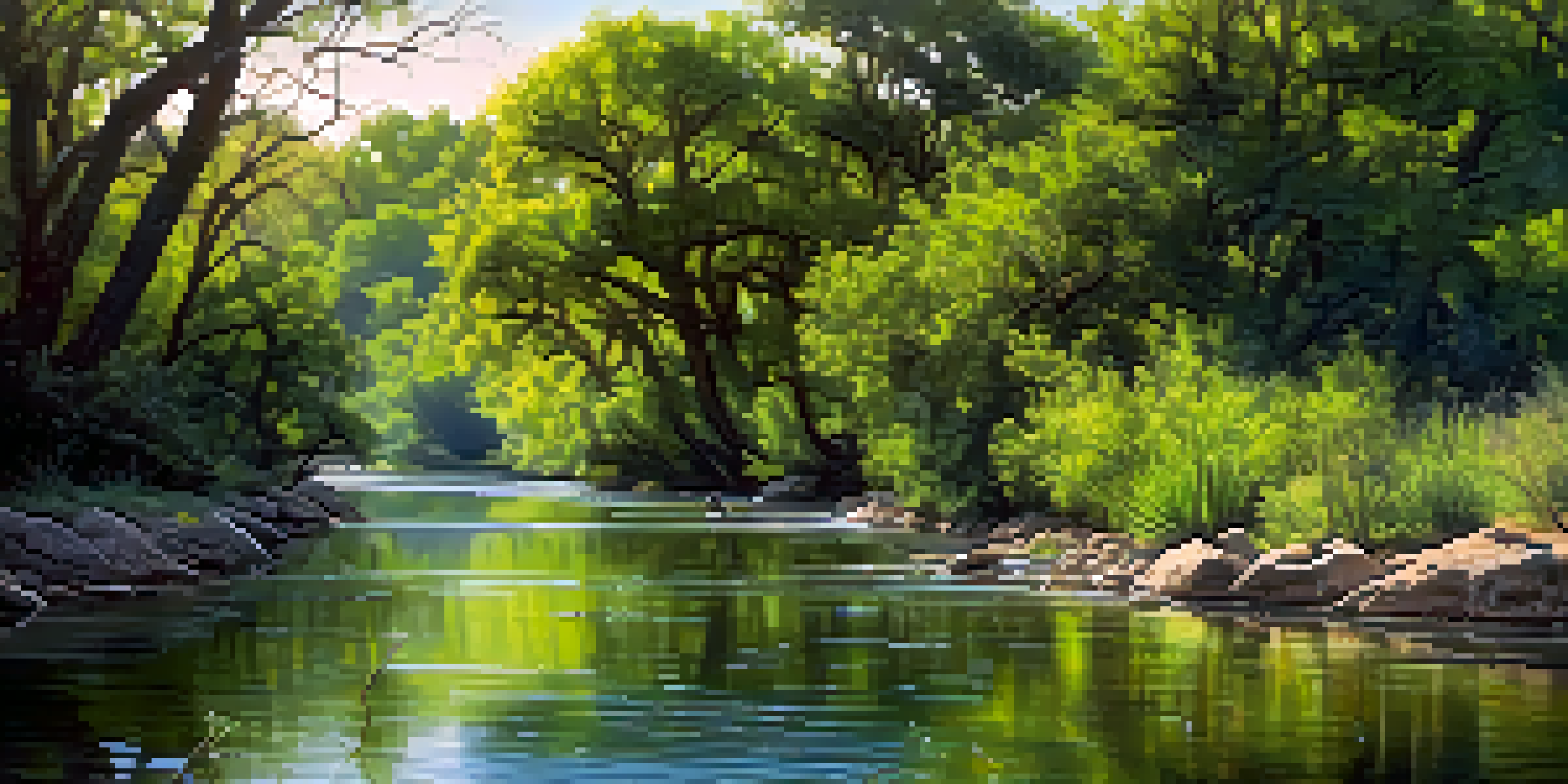Exploring San Jose's Unique Wildlife Habitats and Their Importance

San Jose's Diverse Ecosystems: A Natural Treasure
San Jose is not just a bustling tech hub; it's also a treasure trove of diverse ecosystems. From lush wetlands to sprawling grasslands, these habitats offer a sanctuary for various plant and animal species. Each ecosystem plays a vital role in maintaining biodiversity, which is essential for a healthy environment.
In every walk with nature one receives far more than he seeks.
One of the most prominent ecosystems in the area is the riparian habitat along the Guadalupe River. This area is rich with vegetation and serves as a crucial habitat for migratory birds and other wildlife. The interaction between land and water here creates a unique environment that supports a variety of species.
Moreover, the diverse habitats help to filter pollutants, manage stormwater, and protect against erosion. By nurturing these ecosystems, we not only preserve wildlife but also enhance the quality of life for San Jose residents.
The Role of Urban Parks in Wildlife Conservation
Urban parks in San Jose, like Alum Rock Park and the Municipal Rose Garden, serve as critical wildlife habitats within the city. These green spaces provide refuge for many species, allowing them to thrive amidst the urban landscape. For instance, you might spot butterflies fluttering near flowers or squirrels darting between trees.

These parks not only support wildlife but also offer residents a chance to connect with nature. Walking trails, picnic areas, and educational programs create opportunities for people to learn about local wildlife and conservation efforts. This connection fosters a sense of stewardship for the environment.
San Jose's Ecosystems Boost Biodiversity
The diverse ecosystems in San Jose, including wetlands and grasslands, are vital for maintaining biodiversity and supporting various plant and animal species.
Furthermore, urban parks contribute to ecological health by providing corridors for wildlife movement. This connectivity is crucial for species that need to migrate or search for food, ensuring their survival even in a city environment.
Wetlands: The Unsung Heroes of San Jose's Ecosystem
Wetlands in San Jose, such as the San Francisco Bay wetlands, are often overlooked but are vital for biodiversity. They act as natural filters, trapping pollutants and providing a habitat for countless organisms. These areas are especially crucial for migratory birds that rely on wetlands for resting and feeding during their long journeys.
The greatest threat to our planet is the belief that someone else will save it.
In addition to supporting wildlife, wetlands play a significant role in flood control. They absorb excess rainwater, reducing the risk of flooding in surrounding areas. This natural flood management system is not only cost-effective but also helps preserve the delicate balance of the local ecosystem.
Moreover, wetlands are essential for carbon sequestration, helping to combat climate change. By storing carbon in their soil and vegetation, these habitats serve as a natural solution to one of the most pressing environmental issues today.
Grasslands: A Vital Habitat for Native Species
San Jose's grasslands are often seen as simple fields, but they are teeming with life and play a crucial role in the ecosystem. These open spaces provide habitat for many native species, including various birds, insects, and mammals. The rich diversity of grasses and wildflowers supports pollinators, which are essential for food production.
In addition to their ecological importance, grasslands are also a key component of the region's cultural heritage. Many local tribes historically relied on these habitats for food and medicine, highlighting the deep connection between nature and community. Preserving these landscapes honors that legacy while ensuring future generations can enjoy them.
Urban Parks Enhance Wildlife Habitats
Urban parks in San Jose provide essential refuge for wildlife while offering residents opportunities to connect with nature and learn about conservation.
Grasslands also act as carbon sinks, helping to mitigate climate change by absorbing carbon dioxide from the atmosphere. By protecting these areas, we not only support wildlife but also contribute to a healthier planet.
Understanding the Impact of Urban Development
While urban development brings growth and opportunity, it also poses threats to San Jose's wildlife habitats. As natural areas are paved over or altered, many species lose their homes and food sources. This disruption can lead to a decline in biodiversity, affecting the entire ecosystem.
However, with thoughtful planning and community involvement, we can balance development with conservation. Green building practices, habitat restoration projects, and protected areas can all work together to preserve essential wildlife habitats. Engaging the community in these efforts fosters a shared commitment to protecting our natural resources.
It's crucial for residents to advocate for sustainable development practices that consider the needs of both people and wildlife. By raising awareness and supporting local conservation initiatives, we can help ensure that San Jose remains a haven for diverse wildlife.
Community Involvement: Key to Wildlife Preservation
Community involvement is essential for the preservation of wildlife habitats in San Jose. Local organizations and volunteer groups work tirelessly to restore ecosystems, monitor wildlife populations, and educate residents about the importance of conservation. These grassroots efforts empower individuals to make a difference right in their own backyards.
Participating in local clean-up events, tree planting days, or wildlife surveys can have a significant impact. Not only do these activities enhance the environment, but they also foster a sense of connection and responsibility towards nature. When people engage in these efforts, they often develop a deeper appreciation for the wildlife around them.
Community Action Drives Conservation
Active community involvement is crucial for wildlife preservation, empowering residents to restore habitats and advocate for sustainable development.
Moreover, community initiatives often bridge the gap between residents and local government, encouraging policies that support habitat conservation. By advocating for sustainable practices and funding for local parks, citizens play a critical role in shaping a healthier future for wildlife in San Jose.
The Future of Wildlife Habitats in San Jose
Looking ahead, the future of wildlife habitats in San Jose depends on our collective actions today. As climate change continues to pose challenges, it's imperative to prioritize conservation efforts that enhance the resilience of these ecosystems. By integrating green spaces into urban planning, we can create a sustainable environment for both people and wildlife.
Investing in habitat restoration projects, enhancing biodiversity corridors, and promoting native plant landscaping can all contribute to a thriving ecosystem. Additionally, public education campaigns can raise awareness about the importance of preserving these habitats for future generations.

Ultimately, it's about finding harmony between urban living and nature. By valuing and protecting wildlife habitats, we ensure that San Jose remains a vibrant city teeming with life, creating a legacy of environmental stewardship for years to come.